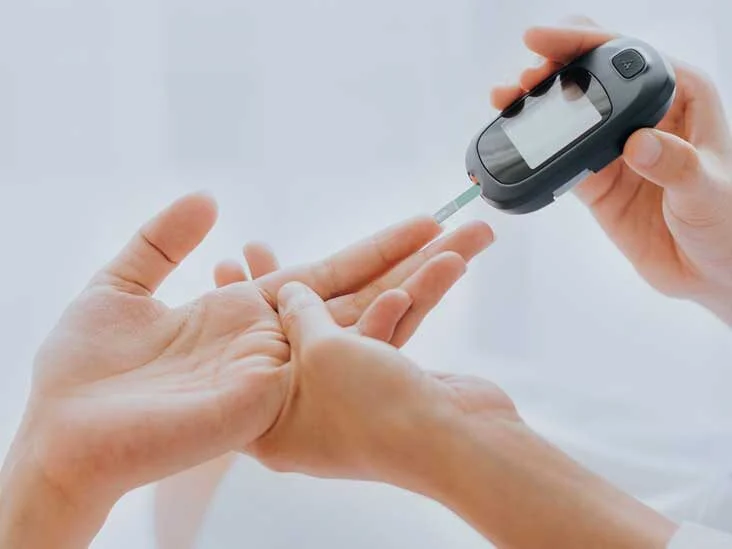
What is insulin?
Insulin is a hormone that is made by cells called beta cells. These are part of little islands of cells (islets) within the pancreas. Hormones are chemicals that are released into the bloodstream and work on various parts of the body. Insulin helps to control the levels of sugar (glucose) in your blood.
How does insulin work?
After you eat, various foods are broken down in your gut into sugars. The main sugar is called glucose and it passes through your gut wall into your bloodstream. However, to remain healthy, your blood sugar level should not go too high or too low.
So, when your blood sugar level begins to rise (after you eat), the level of insulin should also rise. Insulin works on the cells of your body and makes them take in glucose from the bloodstream. Some of the glucose is used by the cells for energy and some is converted into glycogen or fat (which are stores of energy). When the blood sugar level begins to fall (between meals), the level of insulin falls. Some glycogen or fat is then converted back into glucose which is released from the cells into the bloodstream.
What is insulin used for?
Your doctor may prescribe insulin if you have a condition called diabetes. In this condition, your body does not make enough insulin to meet its needs, or if it does, does not use the insulin it makes effectively. People with diabetes need treatment to control the level of sugar (glucose) in their blood. There are two different types of diabetes:
Type 1 diabetes
Type 1 diabetes is the type of Diabetes that typically develop in children and young adults. In people with type 1 diabetes the body stops making insulin and the blood sugar level goes very high. Treatment to manage blood sugar levels is with insulin injections and a healthy diet.
Dose Adjustment for Normal Eating (DAFNE) is a way of managing type 1 diabetes and provides people with the skills necessary to estimate the carbohydrate in each meal and to inject the right dose of insulin.
Type 2 diabetes
Type 2 Diabetes is the type which occurs mostly in people aged over 40 years but is b coming more common in younger adults and in children. The first-line treatment is diet, weight control and physical activity. If the blood sugar level remains high despite these measures then tablets to reduce the blood sugar level are usually advised. Insulin injections are needed in some cases.
How is insulin taken?
Insulin cannot be taken by mouth, as it is destroyed by the digestive juices in your digestive system. It is therefore given by an injection under the skin. Insulin may come:
In a vial to be injected with a separate syringe.
In a cartridge to be used with an injection-based insulin pen.
In the form of an insulin pump, which gives you insulin regularly throughout the day and tries to mimic the natural delivery of insulin.
How to inject insulin
It is usually injected under the skin into your upper arms, thigh, buttocks or tummy (abdomen). Most people take 2-4 injections of insulin each.
How much insulin to take
The type and amount of insulin you need may also vary each day, depending on what you eat and the amount of exercise you do. Your doctor or nurse will tell you when to inject your doses, as different types of insulins are given at different times in relation to food. It is important that you inject your doses when you have been advised to and not miss out any of your doses of insulin.
What types of insulins are available?
There are different types of insulin available which are classified according to how quickly and for how long they work. Short-acting or soluble insulin works quickly and is usually injected just before meals. Intermediate- and long-acting insulins take longer to work and the effects last longer.
Rapid-acting analogue insulin
This can be injected just before, with or after food. It tends to last between 2 and 5 hours and only lasts long enough for the meal at which it is taken.
Short-acting insulin
This should be injected 15-30 minutes before a meal, to cover the rise in blood-glucose levels that occurs after eating. It has a peak action of 2-6 hours and can last for up to eight hours.
Medium-acting and long-acting insulin
These are taken once or twice a day to provide background insulin or in combination with short-acting insulins/rapid-acting analogues. Their peak activity is between 4 and 12 hours and can last up to 30 hours.
Long-acting analogue insulin
This is usually injected once a day to provide background insulin lasting approximately 24 hours
Mixed insulin
This is a combination of medium-acting and short-acting insulin.
Mixed analogue
This is is a combination of medium-acting insulin and rapid-acting analogue.